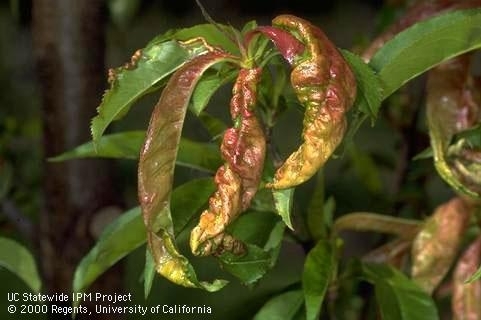Advice for Home Gardeners from the Help Desk of the
UC Master Gardener Program of Contra Costa County
Help Desk Response: Thanks for contacting the UC Master Gardener Help Desk about the problem you are observing on your nectarine tree.
Your nectarine tree is showing the classic symptoms of a fungal disease commonly called "peach leaf curl". It is a common problem for both peaches and nectarines, particularly in years when we have abundant rains as has now occurred this year. The fungal spores that spread the disease can be spread through splashing water and rain.
As you may already have noticed, typically the affected leaves turn yellow or brown and can remain on the tree or may fall off; they are replaced by a second set of leaves that develop more normally unless wet weather continues. Most often the disease will not show up on the developing fruit, but occasionally it does affect fruit, causing corky areas to develop on the fruit surface. Those fruits are still okay to eat—just cut away the affected area.
Unfortunately, there is nothing you can do now to stop the disease on your tree. The typical management approach for controlling peach leaf curl is to use a fungicide in the late fall or early winter months when the tree is dormant. The use of fungicides when the tree is dormant can control the development of the spores that usually survive the hot summer months on the surface of the tree bark. Those spores are reactivated by winter rains and attack the leaves when they emerge in the spring. You should plan now to consider applying such a fungicide in early December, particularly if we are having frequent rains. Just try to schedule the fungicide spraying for a time when you expect to have several successive days of dry weather so that the fungicide can work and not be washed off the tree. You can learn more about peach leaf curl and the use of fungicides to control it at this University of California website: http://ipm.ucanr.edu/PMG/PESTNOTES/pn7426.html
Since fungal spores may also be present on the fallen leaves, it is a good idea to pick up all fallen leaves. Don't put them in your compost pile unless you have a pile that regularly achieves and maintains high temperatures. If your compost piles doesn't have those high temperatures on a regular basis, you can dispose of the leaves in a green bin that goes to a waste company's compost area. Fortunately, those sites typically have compost piles that achieve the high temperatures needed to kill fungal spores.
If you have not yet fertilized your tree, this would be a good time to feed. Just be careful not to use too much fertilizer. It would be better to use less now and re-apply some additional fertilizer is about a month or six weeks. Here's a link to more information on peach tree care: http://homeorchard.ucanr.edu/Fruits_&_Nuts/Peach/ which also applies to nectarine trees.
We hope that this information is helpful. You're welcome to contact us again if you have other questions.
Help Desk of the UC Master Gardener Program of Contra Costa County (TKL)
Note: UC Master Gardeners Program of Contra Costa's Help Desk is available almost year-round to answer your gardening questions. Except for a few holidays (e.g., last 2 weeks December), we're open every week, Monday through Thursday for walk-ins from 9:00 am to Noon at 2380 Bisso Lane, Concord, CA 94520. We can also be reached via telephone: (925) 608-6683, email: ccmg@ucanr.edu, or on the web at http://ccmg.ucanr.edu/Ask_Us/. MGCC Blogs can be found at http://ccmg.ucanr.edu/HortCoCo/ You can also subscribe to the Blog.